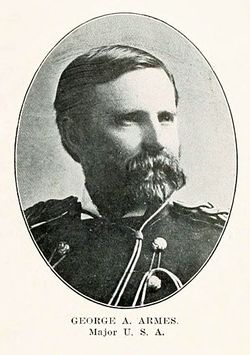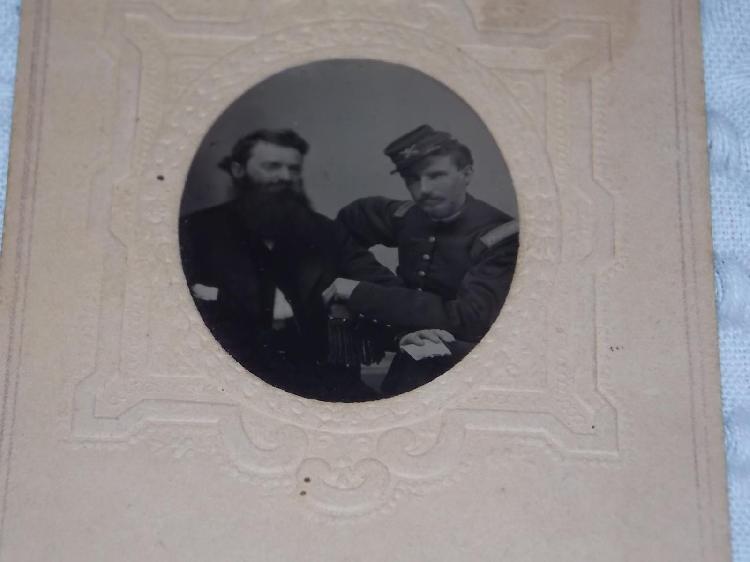Husband of Lucy Hamilton Kerr (2/9/1851-1927, daughter of John Bozman Kerr and Lucy H. Stevens)who he married on 10/14/1874.
Husband of Marie Atkinson (9/15/1864-1944, daughter of Richard Henry Lee Atkinson and Matilda Houghton)who he married on 12/24/1910 in Philadelphia, Pennsylvania.
Father of the following children:
Cecelia "Cecily" Harold Armes 8/1/1875 - 2/1910
(m. Herbert Claude)
Ethel Marie Armes 12/1/1876 - 9/29/1945
George Kerr Armes 10/7/1878 - 8/28/1934
(m. Mabel S. Seale 1/1884 or 1911 - 2/23/1987)
Oscar St John Armes 12/26/1879 -
(m. Dorothea Barnett Drew 1885 - )
Lucy Hamilton Armes 11/1882 - 1/24/1952
(m. James E. Gill)
(m. Julian LaMar AKA Miller 10/14/1893 - 9/6/1967)
Dorothy Neale Armes 1/8/1885 -
(m. Cutler Cannidy)
Edith Armes 1886 -
(m. Unknown Rucker)
Edmund Campion Armes 12/1/1889 -
Herbert Joseph Armes 1891 -
Author of the book, "Ups & Downs of an Army Officer" (1900)about his colorful, heroic and turbulent career in the United States Army, a lot of which is used in this brief biography.
Armes' career in the military brought him fame and a degree of infamy. He very possibly knew or served with almost every major historical figure during the Civil War through about 1900 when he wrote his book to include: Buffalo Bill Cody, George Armstrong Custer, Phil Sheridan, Winfield Scott Hancock, George Meade, William Tecumseh Sherman, James Blaine and many, many more.
During the Civil War Armes chose to fight for the Union even though he was a native of Virginia. While traveling to Washington, D.C., he was captured by Cassius M. Clay, an ardent Southerner, plantation and slave owner who was drilling some men to take to Washington, D.C. to attack the city. When Armes refused to tell Clay where he was going, Clay ordered that Armes was to be hung. Armes escaped and according to his book, saved Washington, D.C. due to the information he provided to the authorities.
During the Civil War, Armes promoted quickly due to his daring and leadership abilities. Serving on the staff of General Winfield Scott Hancock, he was cited for bravery in battle and breveted to the rank of Major in December 1864, the youngest man to hold that rank in the Civil War.
After the Civil War ended, Armes was commissioned into the post-war regular army with the rank of Second Lieutenant and sent out west where he participated in the Indian War campaigns. Once again he served with distinction specifically at the Saline River battle in 1867. The battle with the Indians in Kansas was not overly long. It basically started when Cheyenne Chief Tall Wolf led a band of warriors against some railroad workers in Ellis County, Kansas, killing the all the men. This started more Indian activity in that state and The US Army intervened. Armes, then a captain in Company F, 10th US Colored Cavalry (Buffalo Soldiers) led a his company from Ft. Hayes following a "hostile Indian" trail along the Saline River. Soon the Indians attacked and Armes ordered the troop to form an infantry defensive posture known as the "Hollow Square" with the now dismounted troopers manning the four sides of the square with their horses in the center. But the ground they had been attacked on was not good defensive ground so he walked his square in a retrograde movement back towards Ft. Hayes. After 8 hours and miles of this movement, the Cheyenne warriors disengaged and left the troopers who continued walking in the square for 113 miles. When they were within 10 miles of the fort, the troopers finally mounted their horses and continued on to Ft. Hayes. The total loss to the Buffalo Soldiers was 1 or 3 men, depending on the source one researches with approximately 35 wounded. Armes was lauded for his accomplishment while he passed the praise to his officers and men. Within less than a year, the battles with the Cheyenne in Kansas was over.
In 1869, Armes charged two superior officers who he claimed were selling government mules for their own personal gain. The charges were dismissed against the officers who reportedly had influence in the army and Armes had problems with the Department of the Army for the rest of his military career. He would eventually be Court Martialed on three separate occasions and kicked out of the Army twice, but was allowed back in each time at his request. In 1889 he was forcibly retired from the Army after having assaulted then Governor of Pennsylvania James A. Beaver who had served with Armes and General Hancock during the Civil War. General John Schofield had Armes arrested but was admonished by the United States Supreme Court for that action. General Schofield ordered Armes retirement and reportedly feared that Armes would someday kill him.
On August 21, 1902, Armes was sitting on his porch when a former tenant at one of his properties approached him. The man, J. Roland Johnson, pulled out a gun and fired the weapon twice, hitting Armes once in the right chest. Johnson and Armes had had some difficulty with each other when Johnson was renting from him. Armes traveled to the Army Hospital in Washington, D. C. to have the bullet removed from his chest - apparently it was not a life threatening wound. (New York Times, August 22, 1902)
Armes moved at some point to Ventnor, New Jersey, and retired there for the rest of his life. He passed away at age 75, the last living survivor of General Hancock's Civil War staff.
Husband of Lucy Hamilton Kerr (2/9/1851-1927, daughter of John Bozman Kerr and Lucy H. Stevens)who he married on 10/14/1874.
Husband of Marie Atkinson (9/15/1864-1944, daughter of Richard Henry Lee Atkinson and Matilda Houghton)who he married on 12/24/1910 in Philadelphia, Pennsylvania.
Father of the following children:
Cecelia "Cecily" Harold Armes 8/1/1875 - 2/1910
(m. Herbert Claude)
Ethel Marie Armes 12/1/1876 - 9/29/1945
George Kerr Armes 10/7/1878 - 8/28/1934
(m. Mabel S. Seale 1/1884 or 1911 - 2/23/1987)
Oscar St John Armes 12/26/1879 -
(m. Dorothea Barnett Drew 1885 - )
Lucy Hamilton Armes 11/1882 - 1/24/1952
(m. James E. Gill)
(m. Julian LaMar AKA Miller 10/14/1893 - 9/6/1967)
Dorothy Neale Armes 1/8/1885 -
(m. Cutler Cannidy)
Edith Armes 1886 -
(m. Unknown Rucker)
Edmund Campion Armes 12/1/1889 -
Herbert Joseph Armes 1891 -
Author of the book, "Ups & Downs of an Army Officer" (1900)about his colorful, heroic and turbulent career in the United States Army, a lot of which is used in this brief biography.
Armes' career in the military brought him fame and a degree of infamy. He very possibly knew or served with almost every major historical figure during the Civil War through about 1900 when he wrote his book to include: Buffalo Bill Cody, George Armstrong Custer, Phil Sheridan, Winfield Scott Hancock, George Meade, William Tecumseh Sherman, James Blaine and many, many more.
During the Civil War Armes chose to fight for the Union even though he was a native of Virginia. While traveling to Washington, D.C., he was captured by Cassius M. Clay, an ardent Southerner, plantation and slave owner who was drilling some men to take to Washington, D.C. to attack the city. When Armes refused to tell Clay where he was going, Clay ordered that Armes was to be hung. Armes escaped and according to his book, saved Washington, D.C. due to the information he provided to the authorities.
During the Civil War, Armes promoted quickly due to his daring and leadership abilities. Serving on the staff of General Winfield Scott Hancock, he was cited for bravery in battle and breveted to the rank of Major in December 1864, the youngest man to hold that rank in the Civil War.
After the Civil War ended, Armes was commissioned into the post-war regular army with the rank of Second Lieutenant and sent out west where he participated in the Indian War campaigns. Once again he served with distinction specifically at the Saline River battle in 1867. The battle with the Indians in Kansas was not overly long. It basically started when Cheyenne Chief Tall Wolf led a band of warriors against some railroad workers in Ellis County, Kansas, killing the all the men. This started more Indian activity in that state and The US Army intervened. Armes, then a captain in Company F, 10th US Colored Cavalry (Buffalo Soldiers) led a his company from Ft. Hayes following a "hostile Indian" trail along the Saline River. Soon the Indians attacked and Armes ordered the troop to form an infantry defensive posture known as the "Hollow Square" with the now dismounted troopers manning the four sides of the square with their horses in the center. But the ground they had been attacked on was not good defensive ground so he walked his square in a retrograde movement back towards Ft. Hayes. After 8 hours and miles of this movement, the Cheyenne warriors disengaged and left the troopers who continued walking in the square for 113 miles. When they were within 10 miles of the fort, the troopers finally mounted their horses and continued on to Ft. Hayes. The total loss to the Buffalo Soldiers was 1 or 3 men, depending on the source one researches with approximately 35 wounded. Armes was lauded for his accomplishment while he passed the praise to his officers and men. Within less than a year, the battles with the Cheyenne in Kansas was over.
In 1869, Armes charged two superior officers who he claimed were selling government mules for their own personal gain. The charges were dismissed against the officers who reportedly had influence in the army and Armes had problems with the Department of the Army for the rest of his military career. He would eventually be Court Martialed on three separate occasions and kicked out of the Army twice, but was allowed back in each time at his request. In 1889 he was forcibly retired from the Army after having assaulted then Governor of Pennsylvania James A. Beaver who had served with Armes and General Hancock during the Civil War. General John Schofield had Armes arrested but was admonished by the United States Supreme Court for that action. General Schofield ordered Armes retirement and reportedly feared that Armes would someday kill him.
On August 21, 1902, Armes was sitting on his porch when a former tenant at one of his properties approached him. The man, J. Roland Johnson, pulled out a gun and fired the weapon twice, hitting Armes once in the right chest. Johnson and Armes had had some difficulty with each other when Johnson was renting from him. Armes traveled to the Army Hospital in Washington, D. C. to have the bullet removed from his chest - apparently it was not a life threatening wound. (New York Times, August 22, 1902)
Armes moved at some point to Ventnor, New Jersey, and retired there for the rest of his life. He passed away at age 75, the last living survivor of General Hancock's Civil War staff.
Gravesite Details
United States Army
Family Members
Sponsored by Ancestry
Advertisement
Records on Ancestry
-
Geneanet Community Trees Index
-
Sons of the American Revolution Membership Applications, 1889-1970
-
District of Columbia, U.S., Compiled Marriage Index, 1830-1921
-
U.S., Newspapers.com™ Obituary Index, 1800s-current
-
District of Columbia, U.S., Select Births and Christenings, 1830-1955
Sponsored by Ancestry
Advertisement
















